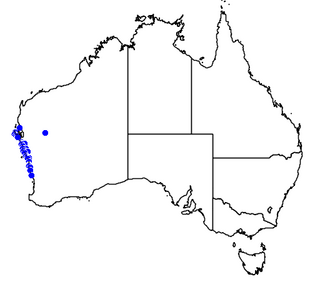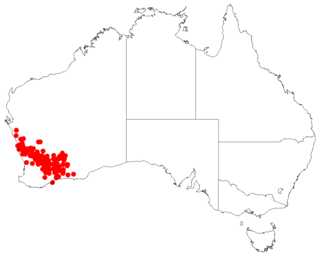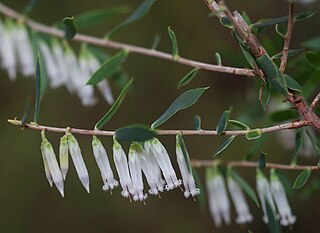
Commersonia borealis is a species of flowering plant in the family Malvaceae and endemic to the southwest of Western Australia. It is a low growing, spreading shrub with egg-shaped to oblong leaves, and white, yellow and cream-coloured flowers.

Grevillea incrassata is a species of flowering plant in the family Proteaceae and is endemic to inland south-western Western Australia. It is an erect shrub with crowded cylindrical or narrowly linear leaves and clusters of bright yellow flowers.
Baeckea elderiana is a species of flowering plant in the family Myrtaceae and is endemic to central Western Australia.
Baeckea grandibracteata is a species of flowering plant in the family Myrtaceae and is endemic to central Western Australia. It is an erect to spreading shrub that typically grows to a height of 0.15 to 0.9 metres and blooms between September and December producing pink and white flowers. Found on undulating sand-plains in the eastern Wheatbelt region of Western Australia in the area around Yilgarn, it grows in sandy and sandy loam soils.
Baeckea grandis is a species of flowering plant in the family Myrtaceae and is endemic to the south-west of Western Australia. It is an ascending to low-lying shrub that typically grows to a height of 0.1 to 0.5 metres and blooms between September and December producing pink and white flowers. Found on sand-plains and hills in the Mid West and northern Wheatbelt regions of Western Australia, it grows in sandy and lateritic soils.

Leucopogon tamminensis is a shrub in the family Ericaceae found in Western Australia.
Baeckea staminosa is a species of flowering plant in the family Myrtaceae and is endemic to the south-west of Western Australia. It is a spreading shrub that typically grows to a height of 25 cm (9.8 in) and is found in wetlands in the Geraldton Sandplains biogeographic region.
Lechenaultia juncea, commonly known as reed-like leschenaultia, is a species of flowering plant in the family Goodeniaceae and is endemic to the south-west of Western Australia. It is an erect, perennial herb or shrub with crowded, fleshy leaves, and pale blue flowers.
Grevillea ceratocarpa is a species of flowering plant in the family Proteaceae and is endemic to inland areas of the south-west of Western Australia. It is an erect or spreading shrub with softly-hairy, narrowly elliptic or narrowly egg-shaped leaves with the narrower end towards the base, and creamy-white flowers.

Lechenaultia stenosepala, commonly known as narrow-sepaled leschenaultia, is a species of flowering plant in the family Goodeniaceae and is endemic to the south-west of Western Australia. It is an open, more or less erect perennial herb or shrub with crowded, narrow leaves, and blue to pale blue or creamy-white flowers.

Mirbelia depressa is a species of flowering plant in the family Fabaceae and is endemic to Western Australia. It is an erect or spreading, prickly shrub that typically grows to a height of 0.15–1 m high and has yellow or orange and reddish-brown flowers from August to October. It was first formally described in 1904 by Ernst Georg Pritzel in the Botanische Jahrbücher für Systematik, Pflanzengeschichte und Pflanzengeographie. The specific epithet (depressa) means "pressed down", referring to the low habit of this species. This mirbelia grows on sandplains and is widespread in the Avon Wheatbelt, Coolgardie, Esperance Plains, Geraldton Sandplains, Gibson Desert, Great Victoria Desert, Mallee, Murchison and Yalgoo and bioregions of Western Australia, and is listed as "not threatened" by the Government of Western Australia Department of Biodiversity, Conservation and Attractions.

Leucopogon cinereus is a species of flowering plant in the heath family Ericaceae and is endemic to the south-west of Western Australia. It is an erect, compact shrub that typically grows to a height of 0.3–1 m and has white flowers from August to October. It was first formally described in 1904 by Ernst Georg Pritzel in Botanische Jahrbücher für Systematik, Pflanzengeschichte und Pflanzengeographie from specimens collected on rocky hills near Gillingarra. The specific epithet (cinereus) means "grey", referring to the colour of the young stems and leaves.

Leucopogon dielsianus is a species of flowering plant in the heath family Ericaceae and is endemic to the south-west of Western Australia. It was first formally described in 1904 by Ernst Georg Pritzel in Botanische Jahrbücher für Systematik, Pflanzengeschichte und Pflanzengeographie from specimens collected near Tammin. The specific epithet (dielsianus) honours Ludwig Diels.
Pimelea gilgiana is a species of flowering plant in the family Thymelaeaceae and is endemic to near-coastal areas of north-western Western Australia. It is a shrub with narrowly egg-shaped leaves and head-like clusters of white or pinkish, dioecious flowers.

Leucopogon hamulosus is a species of flowering plant in the heath family Ericaceae and is endemic to the south-west of Western Australia. It was first formally described in 1904 by Ernst Georg Pritzel in Botanische Jahrbücher für Systematik, Pflanzengeschichte und Pflanzengeographie from specimens he collected near Mingenew. The specific epithet (hamulosus) means "having small hooks" referring to the tips of the leaves.

Leucopogon hispidus is a species of flowering plant in the heath family Ericaceae and is endemic to the south-west of Western Australia. It was first formally described in 1904 by Ernst Georg Pritzel in Botanische Jahrbücher für Systematik, Pflanzengeschichte und Pflanzengeographie from specimens collected near Mingenew. The specific epithet (hispidus) means "with prickly hairs", referring to the leaves.
Thomasia dielsii is a species of flowering plant in the family Malvaceae and is endemic to the south-west of Western Australia. It is a low, erect to spreading shrub with egg-shaped leaves with wavy edges, and purple, violet and blue flowers.
Thomasia multiflora is a species of flowering plant in the family Malvaceae and is endemic to the south-west of Western Australia. It is a low, spreading shrub with broadly egg-shaped leaves and mauve flowers.

Leucopogon mollis is a species of flowering plant in the heath family Ericaceae and is endemic to the south-west of Western Australia. It is a slender, diffuse shrub that typically grows to a height of 0.3–1 m and has white, tube-shaped flowers. The species was first formally described in 1904 by Ernst Georg Pritzel in Botanische Jahrbücher für Systematik, Pflanzengeschichte und Pflanzengeographie from specimens collected on the summit of "Mount Mongerup" in the Stirling Range. The specific epithet (mollis) means "soft".

Leucopogon nutans is a species of flowering plant in the heath family Ericaceae and is endemic to the south-west of Western Australia. It is a shrub that was first formally described in 1904 by Ernst Georg Pritzel in Botanische Jahrbücher für Systematik, Pflanzengeschichte und Pflanzengeographie from specimens collected in Darlington. The specific epithet (nutans) means "nodding".












